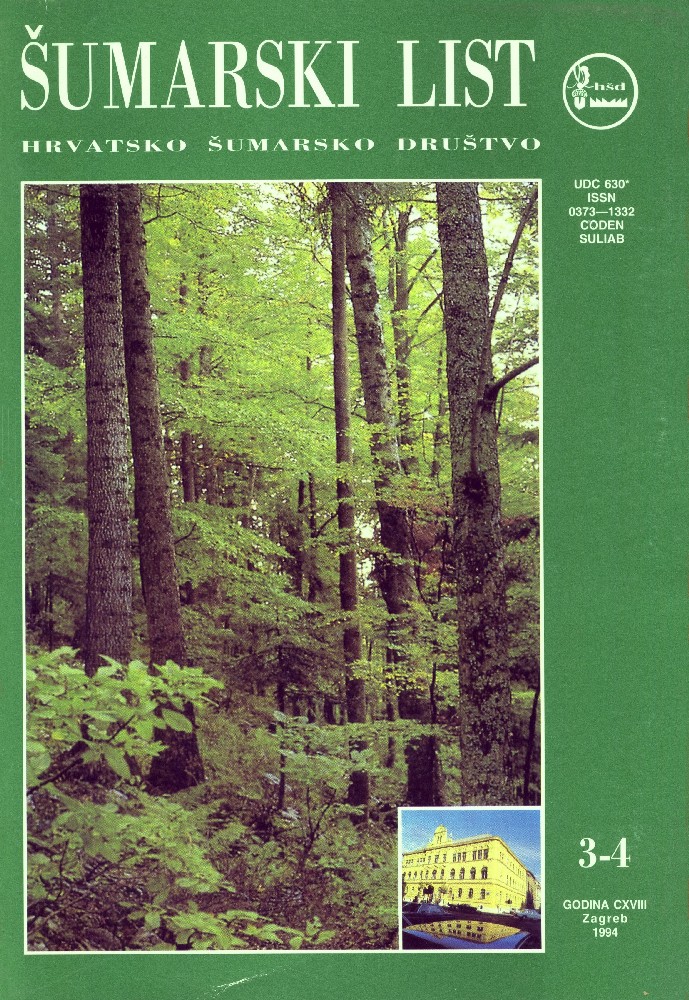
broj: 3-4/1994
pdf (14,6 MB) |
|
||||||||||||||
| IZVORNI ZNANSTVENI ČLANCI | ||
| Matić, S. | UDK 630* 232.319+322.9.001/2 | |
| Number of Plants and the Amount of Seed in Relationship to the Results of Regeneration and Afforestation pdf HR EN | 71 | |
| Summary: Work on natural and artificial regeneration and afforestation should result in a young, newly established stand, which quickly gains the characteristics of the forest in accordance with the definition of a forest, as follows: Forest is represented by the forest soil coherently covered by trees and underbrush, where wooden mass permanently is produced and beneficial properties are expressed in ecological (protective) and social functions of the forest. Nowdays the work on regeneration of the forests encounters the following problems: — Natural regeneration made difficult because of the worsened conditions in and on the soil (weeds, swampy soil, soil drying, etc.) — Absence or impossibility of a high-grade quality seed production — Mistakes in management interventions, especially in tending and reforestation. Number of plants and amount of seed per unit of surface at reforestation and afforestation is a permanently present problem which has to be solved so that newly established stands are guaranteed a good managemental, ecological and social future. Investigation on young (3 and 10 — year old) stands of Pedunculate Oak and Common Hornbeam has proved that these stands at that age have a »capacity« of approximately 40,000 woody plants per hectare with an average standing space of 0.25 m2 per plant. In our opinion at least 80% should be Pedunculate Oak and the remaining 20% should be Common Hornbeam and other secondary tree species. 78 This number of plants confirms the need for broadcast sowing of 800 kg acorns, which would, at 200 acorns per kg and 25% germination capacity, in natural conditions result in approximately 40,000 oak plants per hectare. When establishing forest cultures it is necessary by afforestation to sow the number of plants which, in the shortest possible period of time will transfer the processes of regression into the processes of progression on the site. Having investigated the influence of different numbers of plants per hectare (3,000, 5,000 7,000 10,000 15,000, 20,000) on the growth of foest cultures of Pedunculate Oak at 16 experimental plots, we came to the conclusion that the increase in the number of plants results in the increase of average height and height increment, decreases the amount of weed, tending time and costs per plant. The best results, success and expectancy was displayed by the stand raised with 20,000 plants/ha, but an appreciable improvement is visible already at above 10,000 plants/ha. Sowing a smaller number of plants increases the amount of weeds, which directly competes with the planted seedlings taking from them nourishment, moisture and light, which has an unfavourable effect on the newly established stands. The enclosed Tables 2 and 3 show data on the species for natural and artificial reforestation with regard to the method of sowing and planting, amount of seed, number of plants per hectare (Table 2) and kinds of afforestation (Table 3). The quoted data are recommended to be applied in practice. | ||
| Trinajstić, L. | UDK 630*. *187.001 (497.13) | |
| Mesophilous Hornbeam-Forests (Ass. Anemone-Carpinetum betuli Trinajstić 1964) in Istria (Croatia) pdf HR EN | 81 | |
| Durbešić, P., Vujčić-Karlo, S., Bukvić, I. | UDK 630* 591.9/595.7.001 (497.13) | |
| Faunustic and Zoogeographie Research of Coleoptera-Insecta in some Forest Communities on Mountain Medvednica pdf HR EN | 85 | |
| Raguž, D., Grubešić, M., Tomljanović, J. i Markota, I. | UDK 630* 639.1 (497.13) Ovis ammon musimon Pallas. | |
| Comparison of Trophy Value of some Mouflon Population (Ovis ammon musimon Pallas.) in Croatia pdf HR EN | 91 | |
| PREGLEDNI ČLANCI | ||
| Dimitrov, T. | UDK 630* 431. | |
| Biological Parameters Suitable for Improving the Forest Fire Danger Index pdf HR EN | 105 | |


